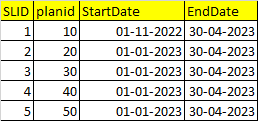Hi @Erland Sommarskog ,
Problem Statement: If partially overlap then return till the next plan and incase of fully overlap then return maxplanid.
Input data is having all the required information just we have to limit no of records based on the condition. I tried myself but didn't get exected results.
Case 1: If plan is partially overlap then return the records between that overlap start and Overlapend date
For Example: Planid : 10 is partially overlap so we need to return Nov and dec because new planid :20 has released from jan-2023.
Case 2: If plan is Fully overlap then return the max plan id records between that overlap start and Overlapend date
For Example: Planid :20,30,40,50 are the fully overlap plans then need to return only max planid :50 records from jan,feb,mar,apr-2023.

-
- **Input Data**
`Create table #target(`
`SLID int,`
`planid int,`
`monthstartdate date,`
`StartDate date,`
`EndDate Date,`
`OverlapstartDate Date,`
`OverlapEndDate Date,`
`OLPlanID int,`
`IsFullOverlap int`
`)`
`insert into #target values`
`(1,10,'2022-11-01','2022-11-01','2023-04-30','2022-11-01','2022-12-31',10,0),`
`(1,10,'2022-12-01','2022-11-01','2023-04-30','2022-11-01','2022-12-31',10,0),`
`(1,10,'2023-01-01','2022-11-01','2023-04-30','2022-11-01','2022-12-31',10,0),`
`(1,10,'2023-02-01','2022-11-01','2023-04-30','2022-11-01','2022-12-31',10,0),`
`(1,10,'2023-03-01','2022-11-01','2023-04-30','2022-11-01','2022-12-31',10,0),`
`(1,10,'2023-04-01','2022-11-01','2023-04-30','2022-11-01','2022-12-31',10,0),`
`(1,20,'2022-11-01','2023-01-01','2023-04-30','2023-01-01','2023-04-30',20,1),`
`(1,20,'2022-12-01','2023-01-01','2023-04-30','2023-01-01','2023-01-01',20,1),`
`(1,20,'2023-01-01','2023-01-01','2023-04-30','2023-01-01','2023-04-30',20,1),`
`(1,20,'2023-02-01','2023-01-01','2023-04-30','2023-01-01','2023-04-30',20,1),`
`(1,20,'2023-03-01','2023-01-01','2023-04-30','2023-01-01','2023-04-30',20,1),`
`(1,20,'2023-04-01','2023-01-01','2023-04-30','2023-01-01','2023-04-30',20,1),`
`(1,30,'2022-11-01','2023-01-01','2023-04-30','2023-01-01','2023-04-30',30,1),`
`(1,30,'2022-12-01','2023-01-01','2023-04-30','2023-01-01','2023-04-30',30,1),`
`(1,30,'2023-01-01','2023-01-01','2023-04-30','2023-01-01','2023-04-30',30,1),`
`(1,30,'2023-02-01','2023-01-01','2023-04-30','2023-01-01','2023-04-30',30,1),`
`(1,30,'2023-03-01','2023-01-01','2023-04-30','2023-01-01','2023-04-30',30,1),`
`(1,30,'2023-04-01','2023-01-01','2023-04-30','2023-01-01','2023-04-30',30,1),`
`(1,40,'2022-11-01','2023-01-01','2023-04-30','2023-01-01','2023-04-30',40,1),`
`(1,40,'2022-12-01','2023-01-01','2023-04-30','2023-01-01','2023-04-30',40,1),`
`(1,40,'2023-01-01','2023-01-01','2023-04-30','2023-01-01','2023-04-30',40,1),`
`(1,40,'2023-02-01','2023-01-01','2023-04-30','2023-01-01','2023-04-30',40,1),`
`(1,40,'2023-03-01','2023-01-01','2023-04-30','2023-01-01','2023-04-30',40,1),`
`(1,40,'2023-04-01','2023-01-01','2023-04-30','2023-01-01','2023-04-30',40,1),`
`(1,50,'2022-11-01','2023-01-01','2023-04-30',NULL,NULL,NULL,NULL),`
`(1,50,'2022-12-01','2023-01-01','2023-04-30',NULL,NULL,NULL,NULL),`
`(1,50,'2023-01-01','2023-01-01','2023-04-30',NULL,NULL,NULL,NULL),`
`(1,50,'2023-02-01','2023-01-01','2023-04-30',NULL,NULL,NULL,NULL),`
`(1,50,'2023-03-01','2023-01-01','2023-04-30',NULL,NULL,NULL,NULL),`
`(1,50,'2023-04-01','2023-01-01','2023-04-30',NULL,NULL,NULL,NULL);`

Thanks In Advance

